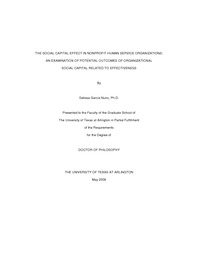
ATTENTION: The works hosted here are being migrated to a new repository that will consolidate resources, improve discoverability, and better show UTA's research impact on the global community. We will update authors as the migration progresses. Please see MavMatrix for more information.
Show simple item record
| dc.contributor.author | Nuno, Delissa Garcia | en_US |
| dc.date.accessioned | 2008-08-08T02:31:11Z | |
| dc.date.available | 2008-08-08T02:31:11Z | |
| dc.date.issued | 2008-08-08T02:31:11Z | |
| dc.date.submitted | April 2008 | en_US |
| dc.identifier.other | DISS-2042 | en_US |
| dc.identifier.uri | http://hdl.handle.net/10106/954 | |
| dc.description.abstract | The study provided for a more complete understanding of social capital theory and its applicability to nonprofit human service organizations (NPHSOs). The initial analysis included an examination of potential outcomes of social capital (e.g., human capital, financial capital, volunteerism, and program effectiveness); and secondly, the study examined possible mediating effects between social capital and program effectiveness in NPHSOs, while controlling for demographic differences. Primary data was collected through a self-administered questionnaire distributed to a sample of NPHSOs, United Way partner agencies in the eight most populated regions in the State of Texas. The survey response rate, after attrition resulted in 42.7% with a sample size of N = 163 NPHSOs. A four-step approach to modeling was selected to examine the data, which required the use of two statistical softwares: SPSS version 15 and Amos version 7. The main statistical technique utilized for hypotheses testing was Structural Equation Modeling (SEM). The SEM approach involved an exploratory rather than confirmatory approach to model specification. An integrated SEM was proposed which incorporated the potential outcomes of social capital as mediating the relationship between social capital and program effectiveness, while controlling for demographic differences. The factor-analytic model, utilizing both a CFA and EFA approach provided valuable insight for model modification to achieve a better data-to-model fit, and helped to determine the most relevant indicators for the study constructs to test the structural model. The model respecification resulted in a final SEM reflective of the results from the EFA and CFA, and was validated by various goodness-of-fit indices. The hypotheses testing resulted in four direct relationships which were statistically supported. Three direct relationships were interpreted as outcomes of social capital, with increased social capital being positively related to total revenue, volunteerism, and program effectiveness. A significant path was also detected from total revenue to human capital in the hypothesized direction. The control variables (age of the organization, size of the organization, and size of region) were positively correlated to total revenue, and size of the organization was positively related to social capital. No mediating effects were supported by the sample data. | en_US |
| dc.description.sponsorship | Rycraft, Joan | en_US |
| dc.language.iso | EN | en_US |
| dc.publisher | Social Work | en_US |
| dc.title | The Social Capital Effect In Nonprofit Human Service Organizations: An Examination Of Potential Outcomes Of Organizational Social Capital Related To Effectiveness | en_US |
| dc.type | Ph.D. | en_US |
| dc.contributor.committeeChair | Rycraft, Joan | en_US |
| dc.degree.department | Social Work | en_US |
| dc.degree.discipline | Social Work | en_US |
| dc.degree.grantor | University of Texas at Arlington | en_US |
| dc.degree.level | doctoral | en_US |
| dc.degree.name | Ph.D. | en_US |
| dc.identifier.externalLink | https://www.uta.edu/ra/real/editprofile.php?onlyview=1&pid=619 | |
| dc.identifier.externalLinkDescription | Link to Research Profiles | |
Files in this item
- Name:
- umi-uta-2042.pdf
- Size:
- 3.864Mb
- Format:
- PDF
This item appears in the following Collection(s)
Show simple item record


